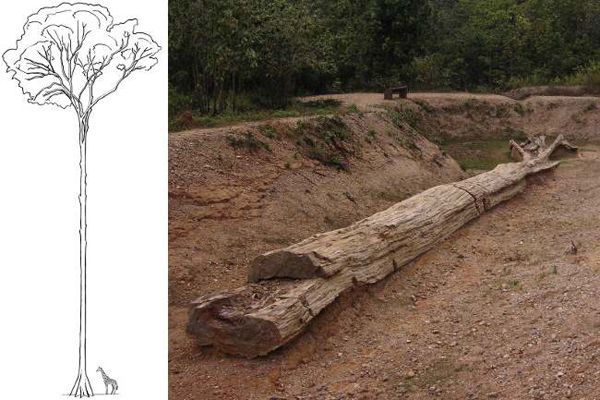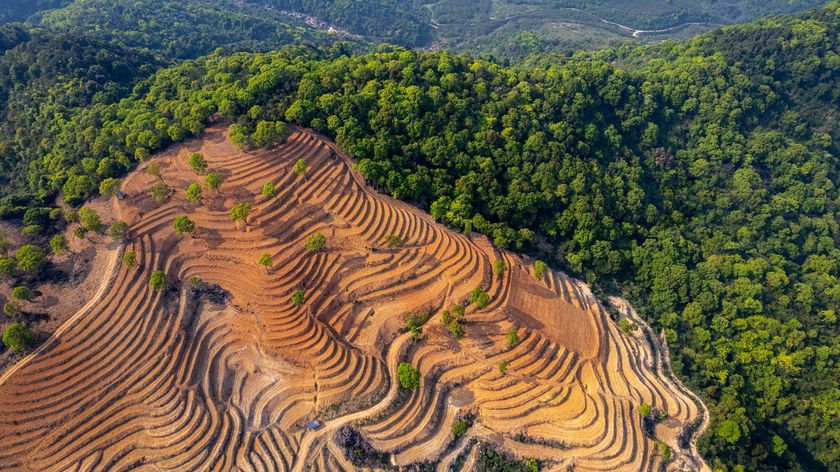
Ancient Giant Trees Found Petrified in Thailand

Fossil trees that approached the heights of today’s tallest redwoods have been found in northern Thailand. The longest petrified log measures 72.2 meters (237 feet), which suggest the original tree towered to more than 100 meters (330 feet) in a wet tropical forest some 800,000 years ago.
The trees appear to have been closely related to a species alive today called Koompassia elegans, which belongs to the same family as beans, peas and black locust trees, explained lead author of the study, Marc Philippe of France’s University of Lyon. That is to say, the ancient trees are not closely related to today’s tallest trees, which are the Eucalyptus (gum trees) of Australia and Sequoia (redwoods) of California. Both of those living trees can reach about 130 meters (425 feet) in height.
Interestingly, there are no trees living today in Thailand that approach the size of the ancients.
Global Warming Pushing Trees North: The Evidence
“Highest trees nowadays in Thailand are almost 60 meters (200 feet),” wrote Philippe in response to my email query about his new paper coming out in the April issue of the journal Quaternary Science Reviews. ”To my knowledge the highest tree yet recorded in Thailand is a Krabak tree, belonging to the Dipterocarpaceae (‘tropical oaks’), 58 meters (190 feet) tall.”
The sediments in which the fossil trees were found suggest that they lived in a wet forest at the edge of a lowland plain. Today the fossil trees are at an elevation of 170 meters (550 feet) above sea level and the climate flips between wet and dry seasons — what’s called monsoonal. Philippe says it’s possible there has been some uplift of the region since the trees fell.
Just how these buried trees were found is an interesting story in itself. A small section of a large petrified log was found ten years ago by a villager in a reserve forest at Ban Tak District, Tak Province. The discovery was reported to officials of the National Park, Wildlife and Plant Conservation Department and so an official came out to examine the log and surveyed the surrounding area. The log was then excavated to a length of 21 meters (70 feet) without reaching the end. Ground penetrating radar was brought in and found that 30 meters (100 feet) of trunk were still unexposed. In 2005, funds were found to excavate the whole trunk. At present, seven of nine discovered petrified trunks have been excavated, mostly in 2005.
Sign up for the Live Science daily newsletter now
Get the world’s most fascinating discoveries delivered straight to your inbox.
“The result was the appearance of what is considered the world’s longest piece of petrified wood, with a length of 72.22 meters” (236.9 feet), the researchers report. “In 2006, the name of the park was changed to the Petrified Forest Park because of the fascinating discoveries.”
NEWS: Big, Old Trees in Decline Worldwide
As to why there were big trees in the past that are unrelated to today’s giant trees, it appears to be just another case of what’s called convergent evolution. That’s where similar environmental factors lead to traits that are similar in unrelated species. Think rheas (South America), ostriches (Africa) and emus (Australia). All are large, unrelated flightless birds that evolved on different continents. I’m not sure what drives trees to grow taller, but a dense forest and a competition for sunlight is part of it. It seems likely that over hundreds of millions of years that plants have been around there have been lots of very tall tree species, probably from every family of plant. It’s just an extremely very rare thing to get an entire petrified trunk to confirm it.
This story was provided by Discovery News.












